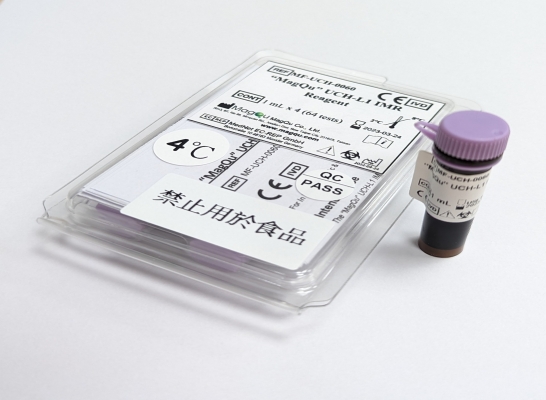Product

“MagQu” UCH-L1 IMR Reagent
- Catalog No. MF-UCH-0060
- CE-IVD Certification
- For rapid quantifying ubiquitin C-terminal hydrolase L1(UCH-L1) by ImmunoMagnetic Reduction (IMR).
- Quantifying UCH-L1 in the sample easily, rapidly, and accurately
- Magnetic Nanoparticle
- Dextran layer
- For traumatic brain injury and Alzheimer’s disease research and for in-vitro diagnosis use
Intended Use
“MagQu” UCH-L1 IMR Reagent is used to quantitatively measure ubiquitin C-terminal hydrolase L1(UCH-L1) in human fluid specimen, such as plasma, serum or CSF.
Use “MagQu” UCH-L1 IMR Reagent only with the XacPro-S System (MagQu Co., Ltd.).
Introduction
Ubiquitin C-terminal hydrolase L1 (UCH-L1) is an extremely abundant deubiquitinating enzyme in brain, which involved in the elimination of misfolded proteins. UCH-L1 is not essential for neuronal development, but is necessary for maintenance of integrity. Recent studies have found an association between UCH-L1 dysfunction and neurodegenerative diseases. In previous studies, UCH-L1 expression was found to be decreased in patients with ischemic injury and Alzheimer's disease. It is possible that UCH-L1 increases free ubiquitin expression by promoting ubiquitination and accelerates lysosomal degradation of amyloid β-synuclein or α-synuclein, which tend to accumulate when they are reduced. Over-expression of UCH-L1 has also been shown in mouse models to effectively delay the progression of Alzheimer's disease. Thus, UCH-L1 may be a pre-dementia process with the potential to predict the onset of dementia. 1,2,3
Principle of Test
“MagQu” UCH-L1 IMR Reagent is designed for rapid quantifying UCH-L1 by ImmunoMagnetic Reduction (IMR). We conjugate antibody on the surface of around 50 nm-in-diameter Fe3O4 magnetic particles. When the antibodies on the surface bind with UCH-L1, the magnetic particles form clusters. Therefore, the ac susceptibility (Xac) of magnetic particles would be reduced in the adding ac magnetic field. By measuring the reduction of Xac, UCH-L1 can be easily, rapidly and accurately quantified.4
References
1. Liu H, Povysheva N, Rose ME, et al. Role of UCHL1 in axonal injury and functional recovery after cerebral ischemia. Proc Natl Acad Sci U S A. 2019;116(10):4643-4650.
2. Setsuie R, Wada K. The functions of UCH-L1 and its relation to neurodegenerative diseases. Neurochem Int. 2007;51(2-4):105-111.
3. Liu MC, Akinyi L, Scharf D, et al. Ubiquitin C-terminal hydrolase-L1 as a biomarker for ischemic and traumatic brain injury in rats. Eur J Neurosci. 2010;31(4):722-732..
4. C.C. Yang, S.Y. Yang, C. S. Ho, et al., "Development of antibody functionalized magnetic nanoparticles for the immunoassay of carcinoembryonic antigen: a feasibility study for clinical use" J Nanobiotechnology. 12: 44. 2014.
| Catalog Number | Description | Package Size |
|---|---|---|
| MF-UCH-0060 | CE-IVD | 1 mL x 4 (64 tests) |
| MF-UCH-0060R | For Research Use Only | 1 mL x 4 (64 tests) |
- Applications Content:Quantitative detection for ultra-low-concentration bio-molecules, e.g. traumatic brain injury and Alzheimer’s disease bio-markers in blood.






